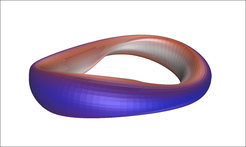Electrons and positrons in an optimised stellarator
Helmholtz Young Investigators Group headed by Eve Stenson takes up work
Dr. Eve Stenson is one of ten young researchers selected by the Helmholtz Association in 2018 to establish their own research group. This was preceded by a multi-stage competition procedure with external peer review.

From December 2019, Eve Stenson, born in Cleveland, Ohio/USA in 1981, is working with her IPP junior research group “Electrons and Positrons in an Optimised Stellarator” to create a plasma of electrons and their antiparticles, the positrons.

The aim of this new branch of the APEX collaboration is to confine a matter-antimatter plasma in a magnetic cage of a small optimised stellarator. It is much simpler but still related to the large stellarator devices of fusion researchers such as Wendelstein 7-X in Greifswald. There, a hydrogen plasma is used to investigate how energy can be generated by nuclear fusion reactions.
Magnetically confined matter-antimatter plasmas have been investigated theoretically and computationally for several decades. However, such a plasma has never been produced in the laboratory before. According to theory, it should show special properties, such as being very stably trapped in certain magnetic field configurations, including optimised stellarators. The aim of the new junior research group will be to produce such plasmas and to investigate them experimentally – thus bringing together two frontiers of plasma physics research, i.e. stellarator optimisation and pair plasma experimentation.
The exotic matter-antimatter plasmas differ from the “normal” plasmas of fusion researchers in one important respect: while the positively and negatively charged particles in an electron-positron plasma have exactly the same mass, the positively charged hydrogen ions in fusion plasmas are much heavier than the negatively charged electrons. This leads to a very different behaviour.

The investigation of exotic matter-antimatter plasmas is therefore expected to provide fundamental insights into the physics of plasmas in general and opportunities to test computational simulations of plasma behaviour. It should even be possible to gain new insights about optimisation that can be used for the planning of new stellarators for fusion research. Since it is assumed that matter-antimatter plasmas occur in the vicinity of neutron stars and black holes, it is also astrophysically interesting to investigate these strange plasmas.
Including last year’s – fifteenth – selection round, the Helmholtz Association has so far made 230 junior research groups possible. The costs – 300,000 euros per year for each group over a period of six years – are shared between the institute where the IPP is based and the Helmholtz Association, to which the IPP is affiliated as an associated institute.


